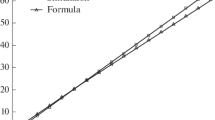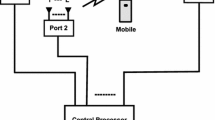Abstract
The large spectral efficiencies promised for multiple-input multiple-output (MIMO) wireless fading channels are derived under certain conditions which do not fully take into account the spatial aspects of the channel. Spatial correlation, due to limited angular spread or insufficient antenna spacing, significantly reduces the performance of MIMO systems. In this paper we explore the effects of spatially selective channels on the capacity of MIMO systems via a new capacity expression which is more general and realistic than previous expressions. By including spatial information we derive a closed-form expression for ergodic capacity which uses the physics of signal propagation combined with the statistics of the scattering environment. This expression gives the capacity of a MIMO system in terms of antenna placement and scattering environment and leads to valuable insights into the factors determining capacity for a wide range of scattering models.
Similar content being viewed by others
References
A. Abdi, J.A Barger and M. Kaveh, A parametric model for the distribution of the angle of arrival and the associated correlation function and power spectrum at the mobile station, IEEE Transactions on Vehicular Technology 51(3) (2002) 425–434.
A. Abdi and M. Kaveh, A space-time correlation model for multielement antenna systems in mobile fading channels, IEEE Journal on Selected Areas in Communications 20(3) (2002) 550–560.
T.D. Abhayapala, T.S. Pollock and R.A. Kennedy, Spatial decomposition ofMIMO wireless channels, in: Seventh Internat. Symposium on Signal Processing and its Applications, Paris, France, 2003.
G.B. Arfken, ed., Mathematical Methods for Physics, 3rd ed. (Academic Press, Orlando, FL, 1985).
W.R. Braun and U. Dersch, A physical mobile radio channel model, IEEE Transactions on Vehicular Technology 40 (1991) 472–482.
C. Chen-Nee, D.N.C. Tse, J.M. Kahn and R.A. Valenzuela, Capacity scaling in MIMO wireless systems under correlated fading, IEEE Transactions on Information Theory 48(3) (2002) 637–650.
D. Chizhik, G.J. Foschini, M.J. Gans and J.M. Kahn, Capacities of multi-antenna transmit and receive antennas: Correlation and keyholes, Electronic Letters 36(13) (2000) 1099–1100.
D. Chizhik, F. Rashid-Farrokhi, J. Ling and A. Lozano, Effect of antenna separation on the capacity of blast in correlated channels, IEEE Communications Letters 4(11) (2000) 337–339.
C.N. Chuah, J.M. Kahn and D.N.C. Tse, Capacity of multi-antenna arrays systems in indoor wireless environment, in: IEEE Global Telecommunications Conf., Sydney, Australia, 1998, pp. 1894–1899.
D. Colton and R. Kress, Inverse Acoustic and Elctromagnetic Scattering Theory (Springer, Berlin, 1992).
R.K. Cook, R.V. Waterhouse, R.D. Berendt, S. Edelman and J.R. Thompson, Measurement of correlation coefficients in reverberant sound fields, Journal of the Acoustical Society of America 27(6) (1955) 1072–1077.
P.F. Driessen and G.J. Foschini, On the capacity formula for multiple-input multiple-output wireless channels: A geometric interpretation, IEEE Transactions on Communications 47(2) (1999) 173–176.
G.J. Foschini and M.J. Gans, On limits of wireless communications in a fading environment when using multiple antennas, Wireless Personal Communications 6(3) (1998) 311–335.
J. Fuhl, J.P. Rossi and E. Bonek, High resolution 3D direction-of-arrival determination for urban mobile radio, IEEE Transactions on Antennas and Propagation 45 (1997) 672–682.
D. Gesbert, H. Bolcskei, D. Gore and A. Paulraj, MIMO wireless channels: Capacity and performance prediction, in: IEEE Global Communications Conf., San Francisco, USA, 2000.
D. Gesbert, H. Bolcskei, D. Gore and A. Paulraj, Outdoor mimo wireless channels: Models and performance prediction, IEEE Transactions on Communications 50(12) (2002) 1926–1934.
D. Gesbert, T. Ekman and N. Christophersen, Capacity limits of dense palm-sized MIMO arrays, in: IEEE Global Communications Conf., Taipei, Taiwan, 2002.
D. Gesbert, M. Shafi, D.S. Shiu, P. Smith and A. Naguib, From theory to practice: An overview of MIMO space-time coded wireless systems, Special Issue on MIMO Systems of IEEE Journal on Selected Areas in Communications 21(3) (2003) 281–302.
A. Gorokhov, Transmit diversity versus sdma: analytic and numerical comparisons, in: IEEE Internat. Conf. on Communications, New Orleans, LA, 2000, pp. 1020–1024.
W.C. Jakes, Microwave Mobile Communications (Wiley, New York, 1974).
H.M. Jones, R.A. Kennedy and T.D. Abhayapala, On dimensonality of multipath fields: Spatial extent and richness, in: IEEE Internat. Conf. on Acoustics, Speech and Signal Processing, Orlando, FL, 2002.
M. Kalkan and R.H. Clarke, Prediction of the space-frequency correlation function for base station diversity reception, IEEE Transactions on Vehicular Technology 46 (1997) 176–184.
J.P. Kermoal, L. Schumacher, K.I. Pedersen, P.E. Mogensen and F. Frederiksen, A stochastic mimo radio channel model with experimental validation, IEEE Journal on Selected Areas in Communications 20(6) (2002) 1211–1226.
W.C.Y. Lee, Effects on correlation between two mobile radio base-station antennas. IEEE Transactions on Vehicular Technology 22(4) (1973) 130–140.
W.C.Y. Lee, Finding the approximate angular probability density function of wave arrival by using a directional antenna, IEEE Transactions on Antennas and Propagation 21 (1973) 328–334.
T. Lo and J. Litva, Angles of arrival of indoor multipath, Electronic Letters 28 (1992) 1687–1689.
S. Loyka and A. Kouki, New compound upper bound on MIMO channel capacity, IEEE Communications Letters 6(3) (2002) 96–98.
K.V. Mardia, Statistics of Directional Data (Academic Press, London, 1972).
M. Patzold, U. Killat, Y. Li and F. Laue, Modeling, analysis, and simulation of nonfrequency-selective mobile radio channels with asymmetrical doppler power spectral density shapes, IEEE Transactions on Vehicular Technology 46(2) (1997) 494–507.
M. Patzold, L. Yingchun and F. Laue, A study of a land mobile satellite channel model with asymmetrical doppler power spectrum and lognormally distributed line-of-sight component, IEEE Transactions on Vehicular Technology 47(1) (1998) 297–310.
K.I. Pedersen, J.B. Anderson, J.P. Kermoal and P.E. Mogensen, A stochastic multiple-input multipleoutput radio channel model for evaluation of space-time coding algorithms, in: IEEE Vehicular Technology Conf., Boston, MA, 2000, pp. 893–897.
K.I. Pedersen, P.E. Mogensen and B.H Fleury, Power azimuth spectrum in outdoor environment, IEE Electronic Letters 33(18) (1997) 1583–1584.
T.S. Pollock, T.D. Abhayapala and R.A. Kennedy, Antenna saturation effects on dense array MIMO capacity, in: IEEE Internat. Conf. on Acoustics, Speech and Signal Processing, Hong Kong, 2003, pp. 361–364.
J.P. Rossi, J.P. Barbot and A.J. Levy, Theory and measurement of the angle of arrival and time delay of UHF radiowaves using a ring array, IEEE Transactions on Antennas and Propagation 45(5) (1997) 876–884.
J.S. Sadowsky and V. Katedziski, On the correlation and scattering functions of the WSSUS channel for mobile communications, IEEE Transactions on Vehicular Technology 47(1) (1998) 270–282.
J. Salz and J.H. Winters, Effect of fading correlation on adaptive arrays in digital mobile radio, IEEE Transactions on Vehicular Technology 43(4) (1994) 1049–1057.
A.M. Sengupta and P.P. Mitra, Capacity of multivariate channels with multiplicative noise: I. Random matrix techniques and large-n expansions fo full transfer matrices, Technical Report, ATT Bell Labs (2000).
D.-S. Shiu, G.J. Foschini, M.J. Gans and J.M. Kahn, Fading correlation and its effect on the capacity of multielement antenna systems, IEEE Transactions on Communications 48(3) (2000) 502–513.
Q. Spencer, M. Rice, B. Jeffs and S.H. Jensen, A statistical model for angle of arrival in indoor multipath propagation, in: IEEE Vehicular Technology Conf., Phoenix, AZ, 1997, pp. 1415–1419.
P.D. Teal, T.D. Abhayapala and R.A. Kennedy, Spatial correlation for general distributions of scatterers, IEEE Signal Processing Letters 9(10) (2002) 305–308.
E. Telatar, Capacity of multi-antenna Gaussian channels, Technical Report, ATT Bell Labs (1995).
E. Telatar, Capacity of multi-antenna Gaussian channels, European Transactions on Telecommunications 10(6) (1999) 585–596.
J.A. Tsai, R.M. Buehrer and B.D. Woerner, Spatial fading correlation function of circular antenna arrays with Laplacian energy distribution, IEEE Communications Letters 6(5) (2002) 178–180.
R.G. Vaughan, Pattern translation and rotation in uncorrelated source distributions, IEEE Transactions on Antennas and Propagation 46(7) (1998) 982–990.
J.G. Wang, A.S. Mohan and T.A. Aubrey, Angles-of-arrival of multipath signals in indoor environments, in: IEEE Vehicular Technology Conf., Atlanta, GA, 1996, pp. 155–159.
S.Wei, D. Goeckel and R. Janaswamy, On the capacity of fixed length antenna arrays under bandlimited correlated fading, in: Conf. on Information Sciences and Systems, Princeton, 2002, pp. 1088–1093.
Author information
Authors and Affiliations
Corresponding author
Rights and permissions
About this article
Cite this article
Pollock, T.S., Abhayapala, T.D. & Kennedy, R.A. Introducing Space into MIMO Capacity Calculations. Telecommunication Systems 24, 415–436 (2003). https://doi.org/10.1023/A:1026143603179
Issue Date:
DOI: https://doi.org/10.1023/A:1026143603179




